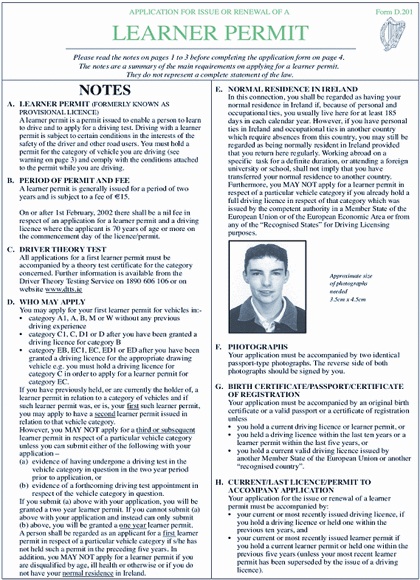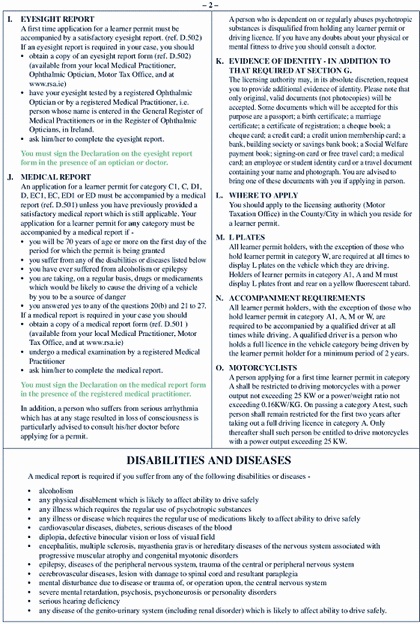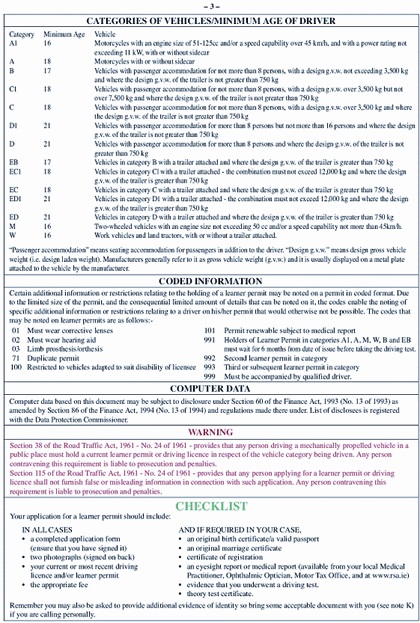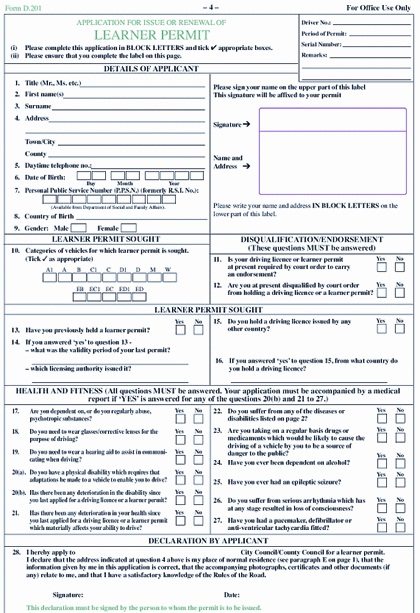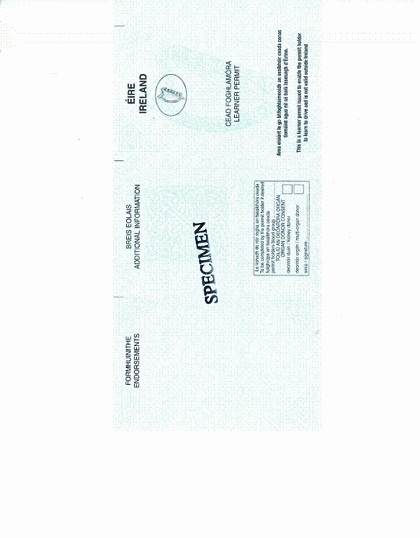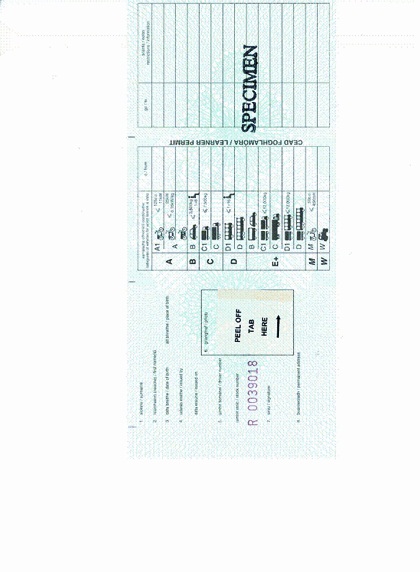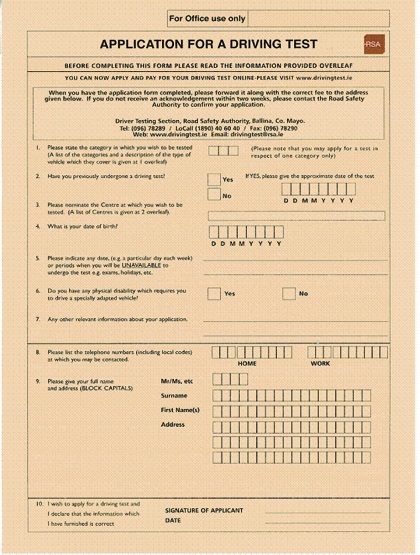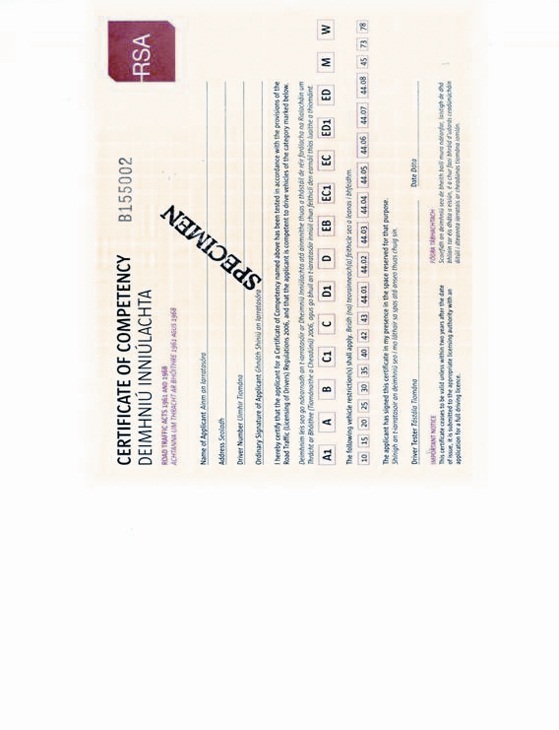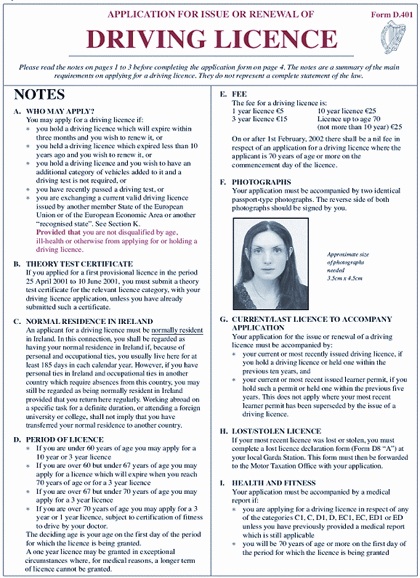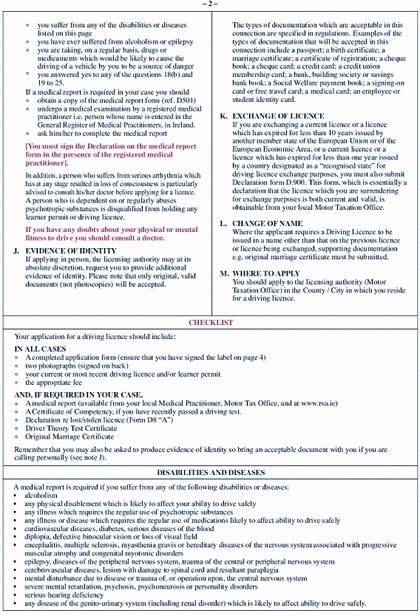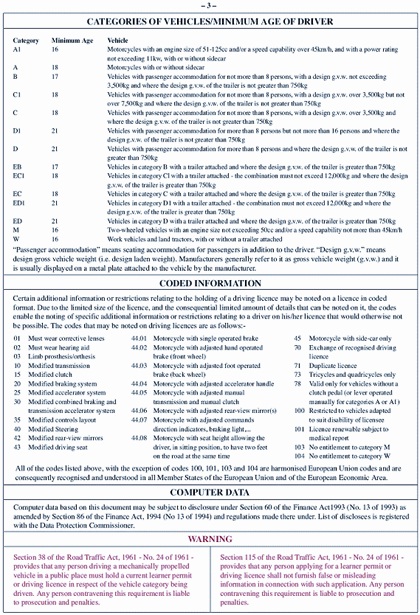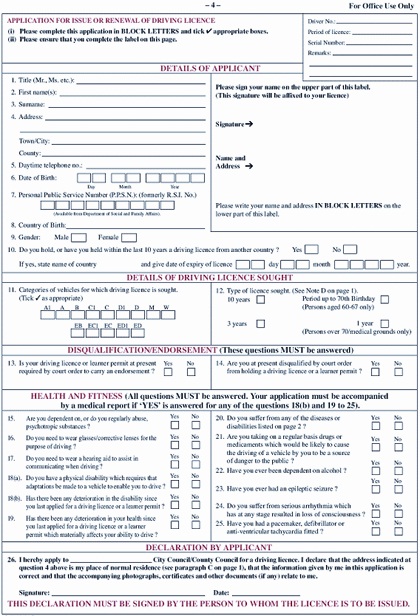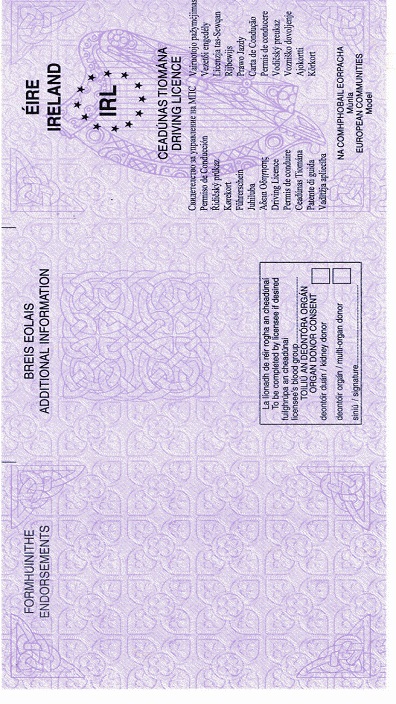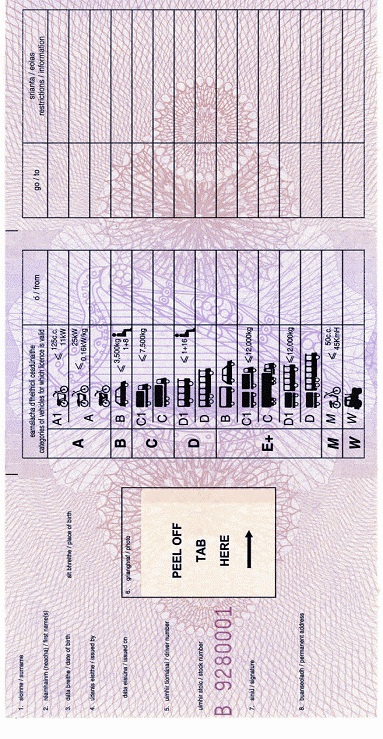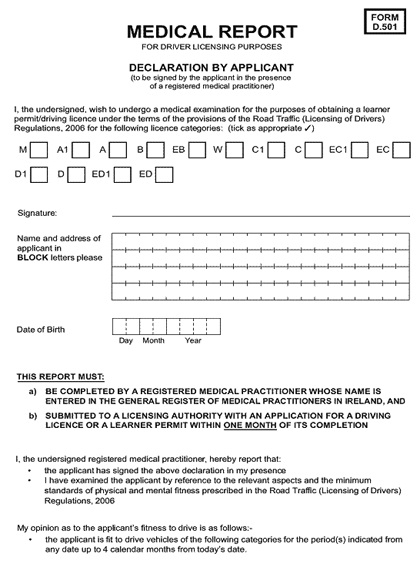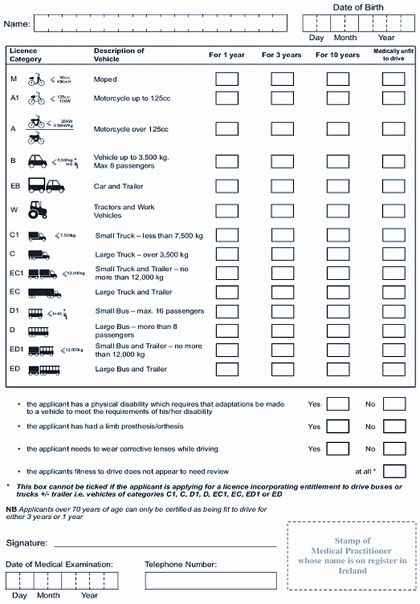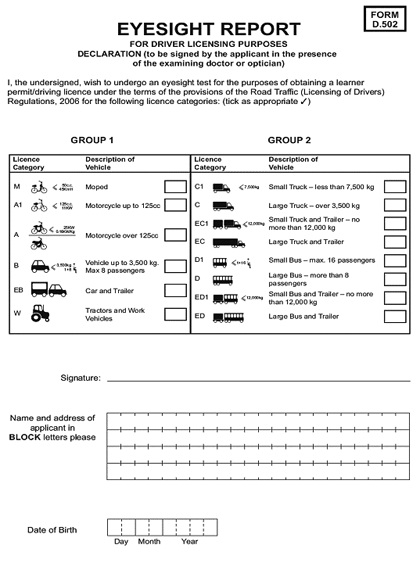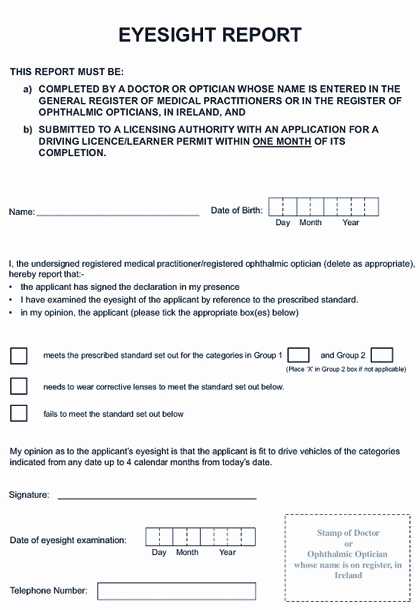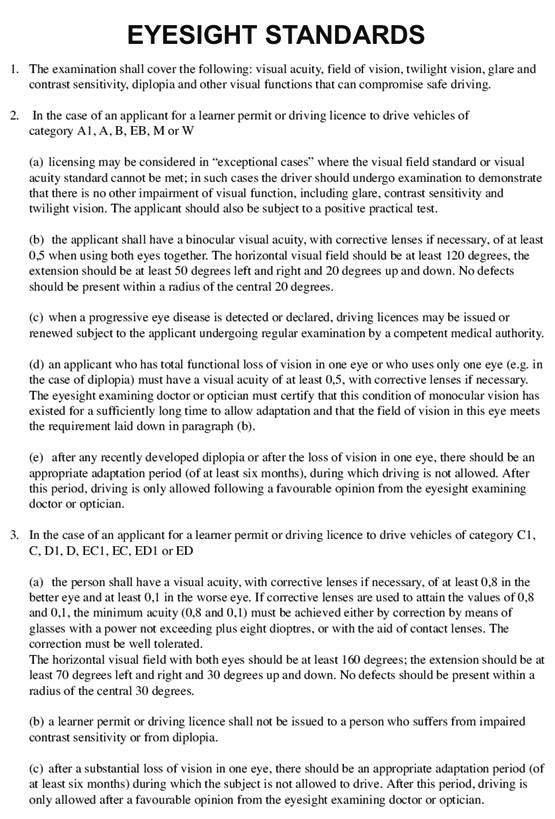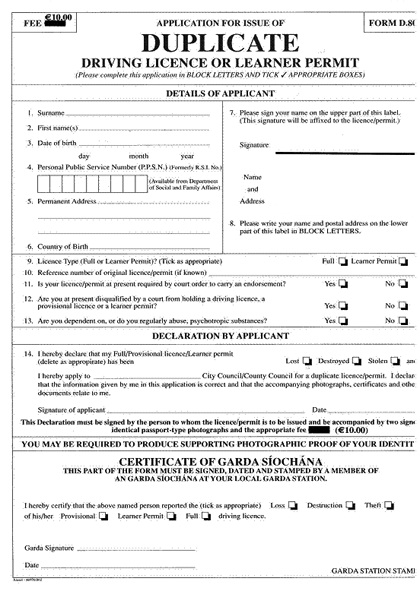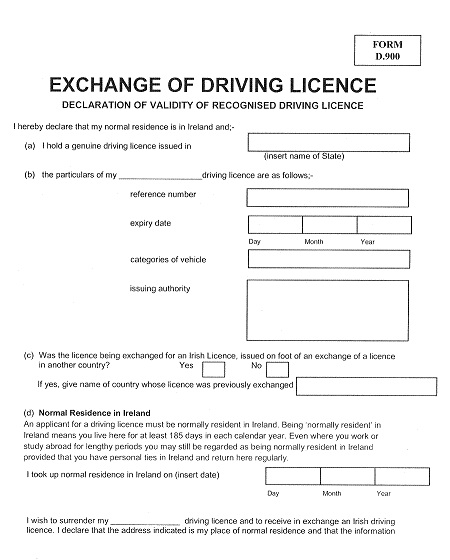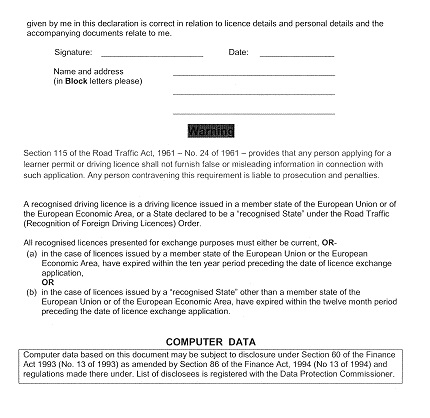S.I. No. 544/2010 - Road Traffic (Licensing of Drivers) (Amendment) (No. 2) Regulations 2010.
Notice of the making of this Statutory Instrument was published in | ||
“Iris Oifigiúil” of 23rd November, 2010. | ||
I, NOEL DEMPSEY, Minister for Transport, in exercise of the powers conferred on me by section 42 (inserted by section 10 of the Road Traffic Act 2006 (No. 23 of 2006)) of the Road Traffic Act 1961 (No. 24 of 1961), section 2 of the Road Traffic Act 2006 and the National Roads and Road Traffic (Transfer of Departmental Administration and Ministerial Functions) Order 2002 ( S.I. No. 298 of 2002 ) (as adapted by the Public Enterprise (Alteration of the Name of Department and Title of Minister) Order 2002 ( S.I. No. 305 of 2002 )) for the purpose of giving effect to Commission Directive No. 2009/112/EC1 of 25 August 2009 and Commission Directive No. 2009/113/EC2 of 25 August 2009, hereby make the following regulations: | ||
1. These Regulations may be cited as the Road Traffic (Licensing of Drivers) (Amendment) (No. 2) Regulations 2010. | ||
2. The Road Traffic (Licensing of Learner Drivers) Regulations 2006 ( S.I. No. 537 of 2006 ), (as amended by the Road Traffic (Licensing of Drivers) (Amendment) Regulations 2008 ( S.I. No. 471 of 2008 )), are amended: | ||
(a) in Regulation 41, by inserting after paragraph (7), the following: | ||
“(8) An application for a driving licence or driving permit for category A1, A, B, M or W, shall be accompanied by an eyesight report, where the application is one for the exchange of a driving licence or driving permit issued by a state other than a Member State.”, | ||
(b) by substituting for Schedule 1 the Schedule set out in Part 1 of the Schedule to these Regulations, | ||
(c) by substituting for Schedule 3 the Schedule set out in Part 2 of the Schedule to these Regulations, | ||
and | ||
(d) by substituting for Schedules 6 and 7 the Schedules set out in Part 3 of the Schedule to these Regulations. | ||
Regulation 3 | ||
SCHEDULE | ||
Part 1 SCHEDULE 1 | ||
Scheduled Forms | ||
Form D201 — Application for learner permit | ||
| ||
| ||
| ||
| ||
| ||
| ||
| ||
| ||
Form D202 —learner permit | ||
Side 1 | ||
| ||
Side 2 | ||
| ||
Form D301 — Application for a certificate of competency. | ||
| ||
| ||
Form D.302 — Certificate of competency. | ||
| ||
| ||
Form D401 — Application for a driving licence. | ||
| ||
| ||
| ||
| ||
| ||
| ||
| ||
| ||
Form D402 — Driving licence. | ||
Side 1. | ||
| ||
| ||
Side 2 | ||
| ||
| ||
Form D.501 — Medical report. | ||
Side 1. | ||
| ||
Side 2.Form. | ||
| ||
| ||
D502 — Eyesight Report. | ||
| ||
| ||
| ||
| ||
| ||
| ||
Form D503 — Certificate of fitness. | ||
| ||
| ||
AN tACHT UM THRÁCHT AR BHÓITHRE, 1961 | ||
ROAD TRAFFIC ACT, 1961 | ||
Ainm an Iarratasóra | ||
Name of Applicant: ............................................ Number | ||
Seoladh | ||
Address: ....................................... | ||
| ||
| ||
| ||
Form D800-Application for duplicate driving licence or duplicate Learner Permit. | ||
| ||
| ||
Form D.900 — Recognised driving licence declaration. | ||
| ||
| ||
| ||
Part 2 | ||
Regulations 12 and 20 | ||
SCHEDULE 3 | ||
Diseases or disabilities where a medical report is required | ||
Alcoholism. | ||
Any physical disablement which is likely to affect ability to drive safely. | ||
Any illness which requires the regular use of psychotropic substances. | ||
Any illness or disease which requires the regular use of medications likely to affect ability to drive safely. | ||
Cardiovascular diseases. | ||
Diplopia, defective binocular vision, impaired contrast sensitivity or loss of visual field. | ||
Serious hearing deficiency. | ||
Mental disturbance due to disease or trauma of, or operation upon, the central nervous system. | ||
Severe mental retardation. | ||
Psychosis. | ||
Psychoneurosis or personality disorders. | ||
Serious diseases of the blood. | ||
Any disease of the genito-urinary system (including renal disorder) which is likely to affect ability to drive safely.” | ||
Part 3 | ||
Regulations 35 and 41 | ||
SCHEDULE 6 | ||
Aspects and standards of physical and mental fitness | ||
Part 1 | ||
Eyesight | ||
1. In the case of an applicant for a learner permit or driving licence, or for the renewal of such a permit or licence, to drive vehicles of category A1, A, B, EB, M or W, the eyesight of the person shall comply with the standards outlined in Schedule 7. | ||
2. In the case of an applicant for a learner permit or driving licence, or for the renewal of such a permit or licence, to drive vehicles of category C1, C, D1, D, EC1, EC, ED1 or ED, the eyesight of the person shall comply with the standards outlined in Schedule 7. | ||
Part 2 | ||
Other Aspects of Physical and Mental Fitness | ||
Preamble. | ||
Driving is more comfortable and safe if all medical conditions are under optimal control. Specialist opinion may be helpful in cases of doubt, not only to help decision-making when driving may no longer be safe but also to ensure a maximisation of health status and the provision of relevant compensatory measures i.e. spectacles, car choice, vehicle adaptations, physiotherapy. | ||
General. | ||
1. (1) In the case of an applicant for a licence or permit, or the renewal of a licence or permit, to drive a vehicle of any category, the medical examination shall take account of the following aspects of the applicant’s physical and mental condition: | ||
ear conditions (vertigo and labyrinthine conditions), | ||
general physique and physical disabilities, | ||
condition of cardiovascular system, | ||
Condition of haemopoietic system, | ||
Condition of endocrine system, | ||
Condition of respiratory system, | ||
Condition of gastro-intestinal system, | ||
Condition of genito-urinary system, | ||
Condition of nervous system, | ||
Condition of mental system, | ||
In so far as any condition of abnormality in any one or more of these aspects would affect such person’s fitness to drive safely vehicles of that category having regard to— | ||
(a) the ability of the person concerned, both physically and mentally, to operate efficiently and safely the controls of the vehicles and to continue so to operate the controls over a reasonable period, | ||
(b) the susceptibility of the person concerned to sudden incapacity, such as loss of consciousness, fainting or giddiness, which might affect such person’s ability to operate the controls of the vehicle so as to bring the vehicle to stop safely, and | ||
(c) the susceptibility of the person concerned to fatigue such that such person’s ability to operate the controls of the vehicle might be seriously impaired. | ||
(2) Fitness to drive shall not be certified in the case of an applicant to drive a vehicle of any category who suffers from any condition or abnormality in any one or more of the aspects of such person’s physical and mental condition set out in sub paragraph (1) of this paragraph to such extent that the driving by the applicant of vehicles of the category to which the application relates would be a danger to the applicant or other road users. | ||
(3) Special attention shall be paid to the additional risks and dangers involved in driving vehicles of category C1, C, D1, D, EC1, EC, ED1 or ED. | ||
General Physique and Physical Disabilities. | ||
2. (1) As a general rule, fitness to drive shall not be certified in respect of persons suffering from complaints or abnormalities of the locomotor system which make it dangerous for them to drive a power-driven vehicle. | ||
(2) In the case of an applicant for a licence or permit, or renewal or a licence or permit, to drive vehicles of category A1, A, B, EB, M or W, fitness to drive may be certified in respect of physically handicapped persons subject to periodic medical review. Where a person is suffering from a progressive complaint, fitness to drive may be certified on condition that the disabled person is regularly examined to check that the person concerned is still capable of driving the vehicle efficiently and safely. | ||
(3) In the case of an applicant for a licence or permit, or renewal or a licence or permit, to drive vehicles of category C1, C, D1, D, EC1, EC, ED1 or ED, the medical examination shall cover the full range of body movements — strength, control and co-ordination — and in particular, movements of the upper and lower limbs. Fitness to drive shall not be certified if the applicant has any disablement which is likely to prevent the proper and safe control of such vehicles. | ||
Hearing. | ||
3. In the case of an applicant for a licence or permit, or renewal or a licence or permit, to drive a vehicle of category C1, C, D1, D, EC1, EC, ED1 or ED, fitness to drive shall not be certified if the applicant’s hearing is so deficient that it interferes with the proper discharge of his or her duties as a driver. | ||
Cardiovascular Diseases. | ||
4. (1) Any disease capable of exposing an applicant for a first licence or a driver applying for a renewal of a licence to a sudden failure of the cardiovascular system such that there is a sudden impairment of the cerebral functions constitutes a danger to road safety. | ||
(2) In the case of an applicant for a licence or permit, or renewal or a licence or permit, to drive vehicles of category A1, A, B, EB, M or W, the following should be noted— | ||
(a) fitness to drive shall not be certified if the applicant suffers from serious arrhythmia resulting in loss of consciousness. | ||
In this connection, persons with ventricular tachyarrhythmias treated by an implantable cardioverter-defibrillator (ICD) have an ongoing risk of sudden incapacitation that might cause harm to others while driving. Such persons with New York Heart Functional Class III shall not be certified as being fit to drive. However, fitness to drive may be certified in respect of such patients with New York Heart Functional Class I or II subject to— | ||
(i) certification by a consultant cardiologist, and | ||
(ii) regular medical review, | ||
(b) fitness to drive may be certified in respect of persons wearing a pacemaker subject to regular medical review, | ||
(c) the question whether to certify a person suffering from abnormal arterial blood pressure as being fit to drive shall be assessed with reference to the other results of the medical examination, any associated complications and the danger they might constitute to road safety, and | ||
(d) generally speaking, fitness to drive shall not be certified in respect of persons suffering form angina during rest or emotion. Persons who have suffered myocardial infarction may be certified as being fit to drive subject to regular medical review. | ||
(3) In the case of an applicant for a licence to drive vehicles of category C1, C, D1, D, EC1, EC, ED1 or ED who suffers from cardiovascular diseases, the medical examination shall take due account of the additional risks and dangers involved in the driving of such vehicles. | ||
Endocrine Disorders. | ||
5. (1) In the following paragraphs, a severe hypoglycaemia means that the assistance of another person is needed and a recurrent hypoglycaemia is defined as a second severe hypoglycaemia during a period of 12 months. | ||
(2) Driving licences shall not be issued to, nor renewed for, applicants or drivers who have recurrent severe hypoglycaemia or/and impaired awareness of hypoglycaemia. A driver with diabetes should demonstrate an understanding of the risk of hypoglycaemia and adequate control of the condition. | ||
(3) A severe hypoglycaemic event during waking hours, even unrelated to driving, should be reported to the medical practitioner and should give rise to a reassessment of the licensing status. | ||
(4) In the case of an applicant for a learner permit or driving licence, or for the renewal of such a permit or licence, to drive vehicles of category A1, A, B, EB, M or W permits or licences may be issued to, or renewed for, applicants or drivers who have diabetes mellitus. When treated with medication, they should be subject to authorised medical opinion and regular medical review, appropriate to each case, but the interval should not exceed five years. | ||
(5) In the case of an applicant for a learner permit or driving licence, or for the renewal of such a permit or licence, to drive vehicles of category C1, C, D1, D, EC1, EC, ED1 or ED consideration may be given to the issuing permits/licences to persons with diabetes mellitus. When treated with medication which carries a risk of inducing hypoglycaemia (that is, with insulin, and some tablets), the following criteria should apply: | ||
(a) no severe hypoglycaemic events have occurred in the previous 12 months, | ||
(b) the driver has full hypoglycaemic awareness, | ||
(c) the driver must show adequate control of the condition by regular blood glucose monitoring, at least twice daily and at times relevant to driving, | ||
(d) the driver must demonstrate an understanding of the risks of hypoglycaemia, and | ||
(e) there are no other debarring complications of diabetes. | ||
In these cases, such permit or licences should be issued subject to the opinion of a competent medical authority and to regular medical review, undertaken at intervals of not more than three years. | ||
Diseases of the Nervous System. | ||
6. (1) In the case of an applicant for a licence or permit, or renewal or a licence or permit, to drive a vehicle of any category who suffers from— | ||
(a) encephalitis, multiple sclerosis, myasthenia gravis or hereditary diseases of the nervous system associated with progressive muscular atrophy and congenital myotonic disorders, | ||
(b) diseases of the peripheral nervous system, or | ||
(c) trauma of the central or peripheral nervous system, | ||
fitness to drive shall be certified for a limited period only so as to ensure that the applicant remains under medical supervision. | ||
Neurological disturbances associated with diseases or surgical intervention affecting the central or peripheral nervous system, which lead to sensory or motor deficiencies and affect balance and co-ordination, must be taken into account in relation to their functional effects and the risks of progression. In such cases and in the event of risk of deterioration, fitness to drive shall be for a limited period only. | ||
(2)(a)(i) Epileptic seizures or other sudden disturbances of the state of consciousness constitute a serious danger to road safety if they occur in a person driving a power-driven vehicle. | ||
(ii) Epilepsy is defined as having had two or more epileptic seizures, less than five years apart. | ||
(iii) A provoked epileptic seizure is defined as a seizure which has a recognisable causative factor that is avoidable. | ||
(iv) A person who has an initial or isolated seizure or loss of consciousness should be advised not to drive. A specialist report is required, stating the period of driving prohibition and the requested follow-up. | ||
(v) It is extremely important that the person’s specific epilepsy syndrome and seizure type are identified so that a proper evaluation of the person’s driving safety can be undertaken (including the risk of further seizures) and the appropriate therapy instituted. This should be done by a neurologist. | ||
(b) In the case of an applicant for a licence or permit, or renewal or a licence or permit, to drive a vehicle of any category A1, A, B, EB, M or W— | ||
(i) drivers assessed with epilepsy should be under licence review until they have been seizure-free for at least five years; | ||
(ii) if the person has epilepsy, the criteria for an unconditional licence are not met. Notification should be given to the licensing authority; | ||
(iii) provoked epileptic seizure: the applicant who has had a provoked epileptic seizure because of a recognisable provoking factor that is unlikely to recur at the wheel can be declared able to drive on an individual basis, subject to neurological opinion the assessment should be, if appropriate, in accordance with other relevant sections of this Schedule (e.g. in the case of alcohol or other co-morbidity); | ||
(iv) First or single unprovoked seizure: the applicant who has had a first unprovoked epileptic seizure can be declared able to drive after a period of six months without seizures, if there has been an appropriate medical assessment. Drivers with recognised good prognostic indicators may drive sooner; | ||
(v) Other loss of consciousness: the loss of consciousness should be assessed according to the risk of recurrence while driving; | ||
(vi) Epilepsy: persons can be declared fit to drive after a one-year period free of further seizures; | ||
(vii) Seizures exclusively in sleep: the applicant or driver who has never had any seizures other than seizures during sleep can be declared fit to drive so long as this pattern has been established for a period which must not be less than the seizure-free period required for epilepsy. If there is an occurrence of attacks/seizure arising while awake, a one-year period free of further event before licensing is required; | ||
(viii) Seizures without influence on consciousness or the ability to act: the applicant or driver who has never had any seizures other than seizures which have been demonstrated exclusively to affect neither consciousness nor cause any functional impairment can be declared fit to drive so long as this pattern has been established for a period which must not be less than the seizure-free period required for epilepsy. If there is an occurrence of any other kind of attacks/seizures a one-year period free of further event before licensing is required; | ||
(ix) Seizures because of a physician-directed change or reduction of anti-epileptic therapy: the patient may be advised not to drive from the commencement of the period of withdrawal and thereafter for a period of six months after cessation of treatment. Seizures occurring during physician-advised change or withdrawal of medication require three months off driving if the previously effective treatment is reinstated; | ||
(x) Subsequent to curative epilepsy surgery: see paragraph (2)(a)(ii) above. | ||
(c) In the case of an applicant for a licence or permit, or renewal or a licence or permit, to drive a vehicle of any category C1, C, D1, D, EC1, EC, ED1 or ED— | ||
(i) drivers assessed with epilepsy should be under licence review until they have been seizure-free for at least five years; | ||
(ii) the applicant should be without anti-epileptic medication for the required period of seizure freedom and an appropriate medical follow-up has been done. On extensive neurological investigation, no relevant cerebral pathology was established and there is no epileptiform activity on the electroencephalogram (EEG). An EEG and an appropriate neurological assessment should be performed after the acute episode; | ||
(iii) provoked epileptic seizure: the applicant who has had a provoked epileptic seizure because of a recognisable provoking factor that is unlikely to recur at the wheel can be declared able to drive on an individual basis, subject to neurological opinion. An EEG and an appropriate neurological assessment should be performed after the acute episode. A person with a structural intra-cerebral lesion who has increased risk of seizures should not be able to drive vehicles of these categories until the epilepsy risk has fallen to at least 2% per annum. The assessment should be, if appropriate, in accordance with other relevant sections of this Schedule (e.g. in the case of alcohol); | ||
(iv) First or single unprovoked seizure: the applicant who has had a first unprovoked epileptic seizure can be declared able to drive once five years’ freedom from further seizures has been achieved without the aid of anti-epileptic drugs, if there has been an appropriate neurological assessment. Drivers with recognised good prognostic indicators may drive sooner; | ||
(v) Other loss of consciousness: the loss of consciousness should be assessed according to the risk of recurrence while driving. The risk of recurrence should be 2% per annum or less; | ||
(vi)10 years freedom from further seizures shall have been achieved without the aid of anti-epileptic drugs. A licence or permit may be granted sooner than ten years to applicants with recognised good prognostic indicators. This also applies in case of “juvenile epilepsy”. | ||
Certain disorders (e.g. arterio-venous malformation or intra-cerebral haemorrhage) entail an increased risk of seizures, even if seizures have not yet occurred. In such a situation an assessment should be carried out by a competent medical authority; the risk of having a seizure should be 2% per annum or less to allow licensing. | ||
(3) In the case of an applicant for a licence or permit, or renewal or a licence or permit, to drive vehicles of category A1, A, B, EB, M or W who suffers from a cerebrovascular disease, fitness to drive may be certified— | ||
(a) provided that, where necessary, the controls of the vehicle to be driven are suitably rearranged or modified or a suitable special type of vehicle is used, and | ||
(b) for a limited period only so as to ensure that the applicant remains under medical supervision. | ||
(4) In the case of an applicant for a licence or permit, or renewal or a licence or permit, to drive vehicles of category A1, A, B, EB, M or W who has suffered a lesion with damage to the spinal cord and resultant paraplegia, fitness to drive may be certified subject to the vehicle to be driven being fitted with special controls. | ||
(5) In the case of an applicant for a licence to drive vehicles of category C1, C, D1, D, EC1, EC, ED1 or ED, fitness to drive shall not be certified where the applicant suffers, or has at any time suffered, from a cerebrovascular disease or a lesion with damage to the spinal cord and resultant paraplegia. | ||
Mental Disorders. | ||
7. (1) In the case of an applicant for a licence to drive vehicles of category A1, A, B, EB, M or W, the medical examination shall take due account of:— | ||
(a) severe mental disturbance, whether congenital or due to disease, trauma or neurosurgical operation on the central nervous system, | ||
(b) severe mental retardation, | ||
(c) psychosis, which in particular has caused general paralysis; or | ||
(d) severe behavioural problems due to dementia; psychoneurosis; or personality defects or disorders leading to seriously impaired judgement, behaviour or adaptability. | ||
If necessary, certification shall be for a limited period only. | ||
(2) In the case of an applicant for a licence or permit, or renewal or a licence or permit, to drive vehicles of category C1, C, D1, D, EC1, EC, ED1 or ED who suffers from any of the disorders outlined in (1) above, the medical examination shall take due account of the additional risks and dangers involved in the driving of such vehicles. | ||
Alcohol. | ||
8. In the case of an applicant for a licence or permit, or renewal or a licence or permit, to drive vehicles of any category who suffers from or has suffered in the past from alcoholism, fitness to drive may be certified for a limited period only, so as to ensure that the applicant remains under medical supervision. | ||
Drugs (prescription and illicit) and Medications. | ||
9. (1) Abuse: | ||
In the case of an applicant for a licence or permit, or renewal or a licence or permit, to drive vehicles of any category, fitness to drive shall not be certified if the person concerned is dependent on psychotropic substances or, if the person is not dependent on such substances, regularly abuses them. | ||
(2) Regular Use: | ||
(a) In the case of an applicant for a licence or permit, or renewal or a licence or permit, to drive vehicles of category A1, A, B, EB, M or W, fitness to drive shall not be certified if the person concerned regularly uses psychotropic substances, in whatever form, which can hamper the ability to drive safely where the quantities absorbed are such as to have an adverse effect on driving. This shall apply to all other medications or combinations of medications which affect the ability to drive, | ||
(b) In the case of an applicant for a licence or permit, or renewal or a licence or permit, to drive vehicles of category C1, C, D1, D, EC1, EC, ED1 or ED who regularly uses psychotropic substances or medications, the medical examination shall take due account of the additional risks and dangers involved in the driving of such vehicles. | ||
Diseases of the Blood. | ||
10. In the case of an applicant for a licence or permit, or renewal or a licence or permit, to drive a vehicle of any category, special attention shall be paid to serious diseases of the blood. | ||
Renal Disorders. | ||
11. In the case of an applicant for a licence or permit, or renewal or a licence or permit, to drive vehicles of any category, fitness to drive shall not be certified where the applicant suffers from severe renal deficiency to such extent that the driving by the applicant of vehicles of the category to which the application relates would be a danger to the applicant or to other road users. | ||
Miscellaneous provisions. | ||
12. (1) In the case of an applicant for a licence or permit, or renewal or a licence or permit, to drive vehicles of category A1, A, B, EB, M or W who has had an organ transplant or an artificial implant which affects the ability to drive, fitness to drive may be certified subject to periodic medical review. Fitness to drive may also be certified in respect of such persons to drive vehicles of category C1, C, D1, D, EC1, EC, ED1 or ED but due account should be taken of the additional risks and dangers involved in the driving of such vehicles. | ||
(2) As a general rule, where an applicant for a licence or permit, or renewal or a licence or permit, to drive a vehicle of any category suffers from any disorder not mentioned in subparagraph (1) above which gives rise to, or is likely to result in, a functional incapacity affecting safety at the wheel, the medical examination shall take due account of the risks and dangers involved in the driving of the vehicles in question and certification of fitness in such instances shall be subject to periodic medical review. | ||
Regulation 41 | ||
SCHEDULE 7 | ||
Eyesight standards | ||
Eyesight | ||
1. All applicants for a driving licence shall undergo an appropriate investigation to ensure that they have adequate visual acuity for driving power-driven vehicles. Where there is reason to doubt that the applicant’s vision is adequate, he/she shall be examined by a competent medical authority. At this examination attention shall be paid, in particular, to the following: visual acuity, field of vision, twilight vision, glare and contrast sensitivity, diplopia and other visual functions that can compromise safe driving. | ||
2. In the case of an applicant for a learner permit or driving licence, or for the renewal of such a permit or licence, to drive vehicles of category A1, A, B, EB, M or W— | ||
(a) licensing may be considered in “exceptional cases” where the visual field standard or visual acuity standard cannot be met; in such cases the driver should undergo examination by a competent medical authority to demonstrate that there is no other impairment of visual function, including glare, contrast sensitivity and twilight vision. The driver or applicant should also be subject to a positive practical test conducted by a competent authority; | ||
(b) the person shall have a binocular visual acuity, with corrective lenses if necessary, of at least 0.5 when using both eyes together. The horizontal visual field should be at least 120 degrees, the extension should be at least 50 degrees left and right and 20 degrees up and down. No defects should be present within a radius of the central 20 degrees; | ||
(c) when a progressive eye disease is detected or declared, driving licences may be issued or renewed subject to the applicant undergoing regular examination by a competent medical authority; | ||
(d) who have total functional loss of vision in one eye or who use only one eye (e.g. in the case of diplopia) must have a visual acuity of at least 0.5, with corrective lenses if necessary. The competent medical authority must certify that this condition of monocular vision has existed for a sufficiently long time to allow adaptation and that the field of vision in this eye meets the requirement laid down in paragraph (b); | ||
(e) after any recently developed diplopia or after the loss of vision in one eye, there should be an appropriate adaptation period of a minimum duration of 6 months, during which driving is not allowed. After this period, driving is only allowed following a favourable opinion from vision experts. | ||
3. In the case of an applicant for a learner permit or driving licence, or for the renewal of such a permit or licence, to drive vehicles of category C1, C, D1, D, EC1, EC, ED1 or ED— | ||
(a) the person shall have a visual acuity, with corrective lenses if necessary, of at least 0.8 in the better eye and at least 0.1 in the worse eye. If corrective lenses are used to attain the values of 0.8 and 0.1, the minimum acuity (0.8 and 0.1) must be achieved either by correction by means of glasses with a power not exceeding plus eight dioptres, or with the aid of contact lenses. The correction must be well tolerated. The horizontal visual field with both eyes should be at least 160 degrees, the extension should be at least 70 degrees left and right and 30 degrees up and down. No defects should be present within a radius of the central 30 degrees; | ||
(b) a learner permit or driving licence shall not be issued to a person who suffers from impaired contrast sensitivity or from diplopia; | ||
(c) after a substantial loss of vision in one eye, there should be an appropriate adaptation period of a minimum duration of six months during which the subject is not allowed to drive. After this period, driving is only allowed after a favourable opinion from vision experts. | ||
| ||
GIVEN under my Official Seal, | ||
11 November 2010. | ||
NOEL DEMPSEY, | ||
Minister for Transport. | ||
EXPLANATORY NOTE | ||
(This note is not part of the Instrument and does not purport to be a legal interpretation). | ||
These Regulations amend the medical criteria for certification of fitness to drive, in order to give effect to Commission Directive No. 2009/112/EC of 25 August 2009 and Commission Directive No. 2009/113/EC of 25 August, 2009 | ||

